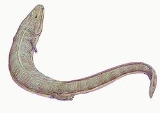
Greererpeton
Encyclopedia
Greererpeton is an extinct genus of tetrapod
s from the Early Carboniferous
period (late Visean
) of North America.
Greererpeton had an elongated body adapted for swimming, reaching up to 1.5 metres (4.9 ft) in length, including the tail. Its body had 40 vertebrae, twice the usual amount, and a flattened skull
about 18 centimetres (7.1 in) long. The limbs were short, and mainly used for steering, with the long tail providing the main propulsive force while swimming.
Some marks on the side of the skull indicate that Greererpeton had a lateral line
, a sensory organ commonly found only in fish. Its ears were also poorly developed. Taken together, these are indications that Greererpeton was a primitive amphibian that had returned to an almost wholly aquatic existence, rarely, if ever, venturing onto dry land.
Greererpeton was a carnivore and probably lived in rivers and swamps.

Tetrapod
Tetrapods are vertebrate animals having four limbs. Amphibians, reptiles, birds and mammals are all tetrapods; even snakes and other limbless reptiles and amphibians are tetrapods by descent. The earliest tetrapods evolved from the lobe-finned fishes in the Devonian...
s from the Early Carboniferous
Carboniferous
The Carboniferous is a geologic period and system that extends from the end of the Devonian Period, about 359.2 ± 2.5 Mya , to the beginning of the Permian Period, about 299.0 ± 0.8 Mya . The name is derived from the Latin word for coal, carbo. Carboniferous means "coal-bearing"...
period (late Visean
Viséan
The Visean, Viséan or Visian is an age in the ICS geologic timescale or a stage in the stratigraphic column. It is the second stage of the Mississippian, the lower subsystem of the Carboniferous. The Visean lasted from 345.3 ± 2.1 to 328.3 ± 1.6 Ma...
) of North America.
Greererpeton had an elongated body adapted for swimming, reaching up to 1.5 metres (4.9 ft) in length, including the tail. Its body had 40 vertebrae, twice the usual amount, and a flattened skull
Skull
The skull is a bony structure in the head of many animals that supports the structures of the face and forms a cavity for the brain.The skull is composed of two parts: the cranium and the mandible. A skull without a mandible is only a cranium. Animals that have skulls are called craniates...
about 18 centimetres (7.1 in) long. The limbs were short, and mainly used for steering, with the long tail providing the main propulsive force while swimming.
Some marks on the side of the skull indicate that Greererpeton had a lateral line
Lateral line
The lateral line is a sense organ in aquatic organisms , used to detect movement and vibration in the surrounding water. Lateral lines are usually visible as faint lines running lengthwise down each side, from the vicinity of the gill covers to the base of the tail...
, a sensory organ commonly found only in fish. Its ears were also poorly developed. Taken together, these are indications that Greererpeton was a primitive amphibian that had returned to an almost wholly aquatic existence, rarely, if ever, venturing onto dry land.
Greererpeton was a carnivore and probably lived in rivers and swamps.


